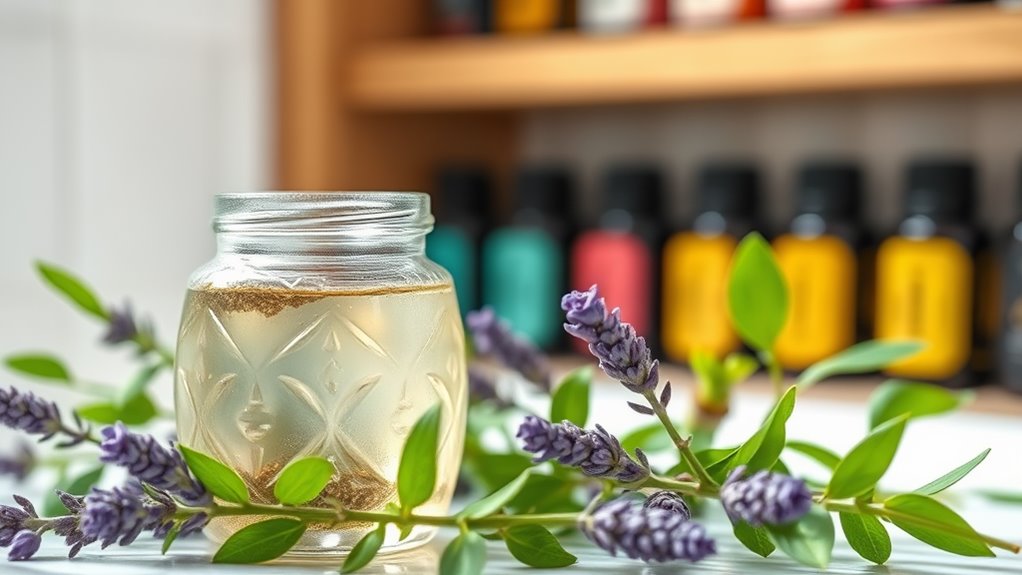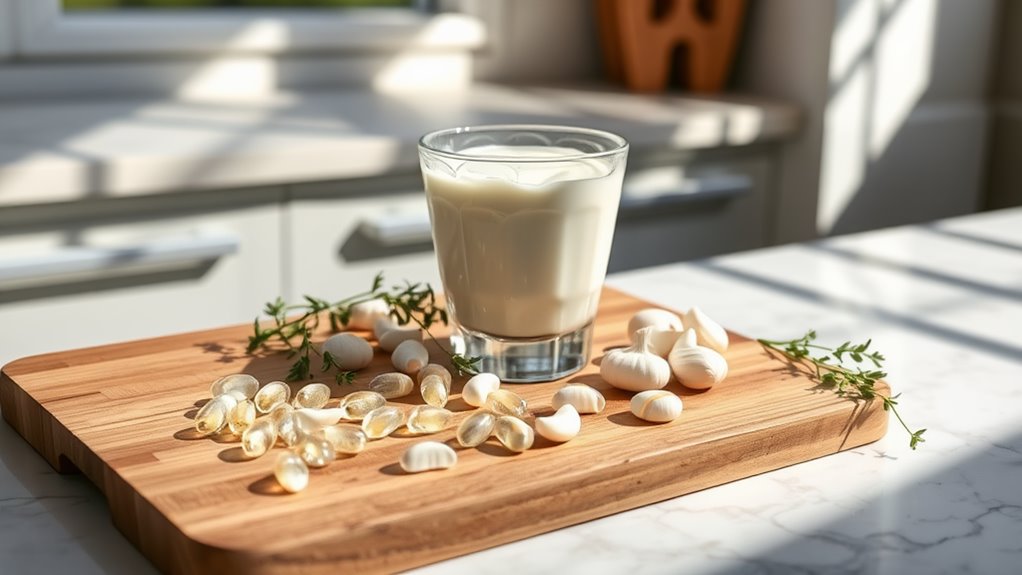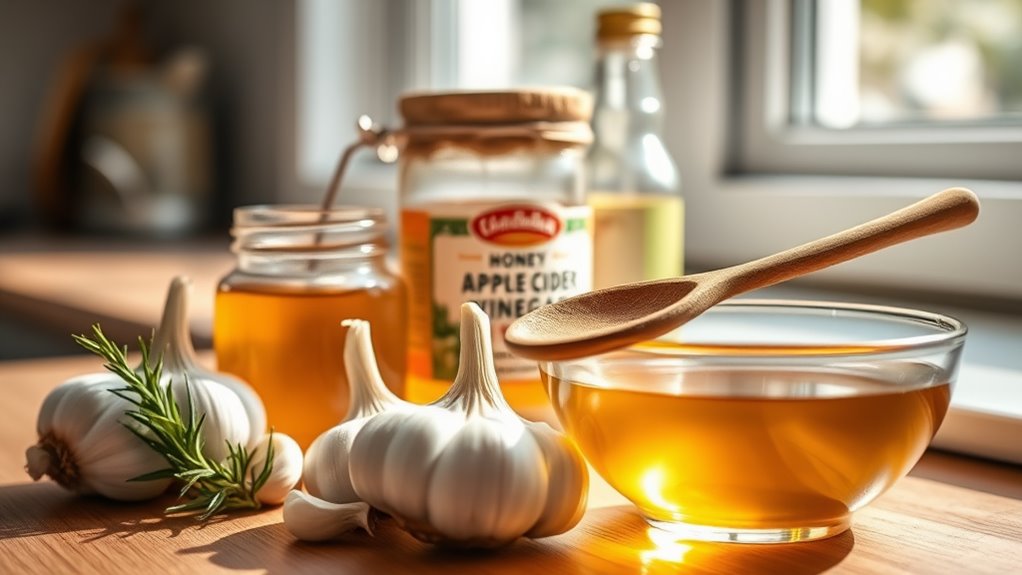The Yeast Infection Remedy You’ll Wish You Knew Sooner
If you’ve ever dealt with a yeast infection, you know how uncomfortable it can be. What if I told you there’s a simple remedy that combines two powerful natural ingredients? Probiotics and garlic might just be the solution you’ve been searching for. They work together to restore balance and fight off infections. Curious about how to incorporate them into your routine and what other steps you can take? Let’s explore further.
Key Takeaways
- Garlic possesses antifungal properties that can effectively combat yeast infections when used as a natural remedy.
- Probiotics from yogurt and kefir help restore healthy bacteria balance, reducing the risk of future infections.
- Over-the-counter treatments like clotrimazole cream and miconazole suppositories provide quick relief for yeast infection symptoms.
- Maintaining proper hygiene and wearing breathable underwear can significantly lower the chances of recurring yeast infections.
- Consult a healthcare provider for accurate diagnosis and treatment, especially for severe or persistent cases.
Understanding Yeast Infections
When you think of yeast infections, you might picture discomfort and irritation, but understanding what they’re can help you manage and prevent them effectively.
A yeast infection occurs when there’s an overgrowth of Candida, a type of fungus normally present in small amounts in your body. Factors like antibiotics, hormonal changes, and a weakened immune system can trigger this overgrowth. Natural remedies for quick relief can also help alleviate symptoms effectively. Additionally, probiotics restore natural balance and combat Candida overgrowth, making them a valuable part of your management strategy.
Recognizing the causes empowers you to take control. To address yeast infections quickly, consider yeast infection remedies fast, such as antifungal creams or medications.
It’s crucial to maintain good hygiene and wear breathable fabrics to reduce your risk. By understanding the factors that contribute to yeast infections, you’re better equipped to prevent and manage them.
Symptoms and Diagnosis
Although yeast infections are common, recognizing their symptoms is essential for prompt diagnosis and treatment. You might experience itching, burning, and discomfort in the vaginal area, often accompanied by a thick, white discharge resembling cottage cheese.
These symptoms can vary in intensity and may worsen during urination or intercourse. Besides vaginal symptoms, some women report swelling and redness of the vulva.
If you suspect you have a yeast infection, it’s vital to consult a healthcare provider for an accurate diagnosis. They may perform a physical examination and, if necessary, a swab to test for yeast.
Early diagnosis can help you find the right treatment and prevent recurrent infections, allowing for a quicker return to comfort and well-being.
Natural Remedies for Yeast Infections
When dealing with yeast infections, natural remedies like garlic and probiotics can be highly effective.
Garlic’s antifungal properties help combat the infection, while probiotics restore balance to your body’s flora.
Exploring these options might lead you to a more holistic approach to your wellness.
Garlic’s Antifungal Properties
Garlic has long been celebrated not just for its culinary uses but also for its powerful antifungal properties, making it a popular natural remedy for yeast infections.
If you’re looking for a way to combat discomfort, garlic might be your answer. Here’s how it can help:
-
Contains Allicin****: This compound fights off yeast growth effectively.
-
Boosts Immunity: Garlic enhances your body’s natural defenses.
-
Reduces Inflammation: It helps soothe irritation associated with infections.
-
Easy to Use: You can incorporate it into meals or take it as a supplement.
-
Natural and Safe: Most people tolerate garlic well with minimal side effects.
Probiotics for Balance
Probiotics play an essential role in maintaining a healthy balance of bacteria in your body, which can be particularly beneficial when dealing with yeast infections.
These beneficial bacteria help keep harmful organisms, like Candida, in check. By restoring your microbiome, probiotics can reduce the risk of overgrowth that leads to infections.
You can find probiotics in fermented foods like yogurt, kefir, and sauerkraut, or as supplements. Incorporating these into your diet not only supports your immune system but also promotes vaginal health.
Over-the-Counter Treatment Options
Over-the-counter treatment options for yeast infections provide quick relief and are easily accessible. You don’t need a prescription to find effective solutions.
These treatments typically contain antifungal ingredients that target the yeast causing your discomfort. Here are some popular options you might consider:
- Clotrimazole cream: A topical treatment that soothes irritation.
- Miconazole suppositories: Insertable forms that deliver medication directly where it’s needed.
- Tioconazole ointment: A single-dose option for those seeking convenience.
- Oral fluconazole: A pill that works systemically to eliminate the infection.
- Anti-itch creams: Helpful for relieving itching and irritation while you treat the infection.
Always read the instructions carefully and consult a healthcare professional if symptoms persist.
Lifestyle Changes to Prevent Recurrence
To prevent the recurrence of yeast infections, you should consider making some key lifestyle changes.
Focusing on dietary modifications and maintaining good hygiene practices can greatly reduce your risk. Additionally, incorporating probiotics from fermented foods into your diet can help maintain a healthy gut microbiome and inhibit harmful yeast growth. Regularly consuming beneficial bacteria through yogurt or supplements supports the immune system and promotes vaginal health.
Dietary Modifications
While many factors contribute to yeast infections, making specific dietary modifications can greatly reduce your risk of recurrence. By adjusting what you eat, you can help maintain a balanced environment in your body.
Here are some dietary changes to ponder:
-
Limit sugar intake: Yeast thrives on sugar, so reducing sweets can help starve it.
-
Increase probiotics: Foods like yogurt and kefir boost healthy bacteria, which can keep yeast in check.
-
Choose whole grains: Opt for whole grains over refined carbs to stabilize blood sugar levels.
-
Stay hydrated: Drink plenty of water to help flush out toxins and maintain balance.
-
Incorporate garlic: Known for its antifungal properties, garlic can be a powerful addition to your meals.
Making these changes can greatly impact your health!
Hygiene Practices
Maintaining proper hygiene is essential for preventing the recurrence of yeast infections. Start by wearing loose-fitting, breathable underwear made from cotton. This helps keep moisture at bay, which yeast loves. After bathing, dry your genital area thoroughly to avoid dampness.
Also, consider using mild, unscented soaps; harsh chemicals can disrupt your natural balance.
When it comes to menstrual hygiene, change your pads or tampons regularly, and opt for breathable products. Avoid douching, as it can disturb the vaginal flora.
Finally, if you’re prone to infections, limit your use of antibiotics and consult your doctor about probiotics. By following these hygiene practices, you can greatly reduce your risk of future yeast infections and maintain your overall vaginal health.
When to See a Doctor
If your yeast infection symptoms persist despite over-the-counter treatments, it’s important to consult a doctor. Ignoring the issue can lead to further complications or chronic infections.
Here are some signs that signal it’s time to seek medical advice:
- Your symptoms worsen or don’t improve after treatment.
- You experience severe pain or discomfort.
- You notice unusual discharge with a foul odor.
- You have recurrent yeast infections (more than three in a year).
- You’re pregnant or have diabetes, which may complicate the situation.
Don’t hesitate to reach out for help. A healthcare professional can provide a proper diagnosis and recommend effective treatments tailored to your needs.
Taking action sooner can lead to quicker relief and better overall health.
Myths and Misconceptions About Yeast Infections
Many people hold onto myths about yeast infections that can lead to confusion and mismanagement of the condition. Understanding what’s true and what’s not can help you make informed decisions. Here are some common misconceptions:
| Myth | Truth |
|---|---|
| Yeast infections are sexually transmitted. | They can occur without sexual activity. |
| Only women get yeast infections. | Men can also be affected. |
| Sugar causes yeast infections. | While sugar can feed yeast, it’s not the sole cause. |
| Home remedies are always effective. | Professional treatment may be necessary. |
Clearing up these myths helps you recognize symptoms early and seek appropriate treatment, ensuring you don’t suffer longer than necessary. Additionally, understanding natural remedies for quick relief can provide immediate comfort while managing symptoms at home. It’s important to remember that keeping living spaces clean can also help prevent yeast overgrowth in the first place.




